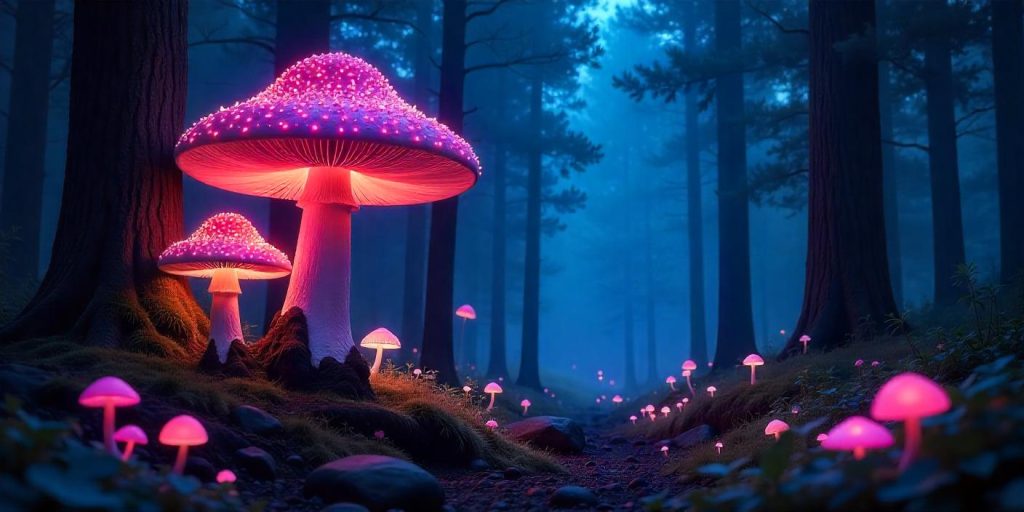Mushrooms come in all forms and sizes, but few are as captivating as the Enigma mushroom. The wild fungi’s unique characteristics and ambiguous nature have eluded even scientists and mycologists for generations. This seldom-seen species is unlike any other, boasting unusual properties and appearances that make it a real outlier in the fungal kingdom. The Enigma, both attention-grabbing and beautiful, is a heavily mythologized mushroom.
Defining the Enigma Mushroom
The enigma mushroom doesn’t have the typical mushroom shape of a cap and a stem. It doesn’t resemble mushrooms like portabello or cremini at all. Instead, it forms dense clusters that are more reminiscent of human brains in appearance, giving the Enigma a distinctive look. Due to their irregular shape, these clusters can be nearly undetectable and camouflaged among rotting leaves and twigs.
Some mycologists, or mushroom scientists, believe the Enigma to be so rare that it could face extinction. Another oddity is that the enigma doesn’t produce spores or reproduce like other mushrooms. It is believed to reproduce vegetatively in the mycelial network of an existing enigma.
Enigma Mushroom Explained
The enigma mushroom does not have the standard appearance of what we think of as a mushroom with a cap and a stem. It doesn’t look anything like them at all. Instead, it forms dense, brain-like clusters indistinguishable from the clusters of a lobelia plant that a person might find in a garden. Both plants grow from above-ground structures and serve as habitats for slugs and other animals. The Enigma has earned its name because of its irregular shape and surface texture. The forest floor often conceals the existing structures, making Enigma mushrooms difficult to find.
The Connection to Psychedelics
What makes the Enigma mushroom intriguing is the very real possibility that it possesses psychoactive properties. Although the species has not been studied, it is believed to be in the Psilocybe genus, a group of mushrooms known for containing the hallucinogenic compounds psilocybin and psilocin. People widely recognize these compounds for their close association with the psychedelic experience.
The relationship between psilocybin and its possible mental health benefits (e.g., treating severe and persistent depression that has thus far proved resistant to more conventional medicines) has received serious and extensive attention from some very eminent neuroscientists in the past few years. Yet the Enigma mushroom’s other possible uses and effects remain undetermined because nobody has tried it.
Cultivation and Legal Position
The Enigma mushroom is mainly a wild species, and its extreme rarity makes it impossible to grow. Unlike many other psychoactive mushrooms, it is not cultivated for use. Moreover, standard mushroom cultivation methods that use mushroom spores to inoculate a substrate are not applicable. Only the mycelium of an existing Enigma culture (cloning) can “grow” the Enigma mushroom, as it does not produce spores. Thus, while it is possible, the federal legal risks of doing so are considerable.
Under federal law (the Controlled Substances Act of 1970), any species of mushroom containing psilocybin or psilocin is considered a “hallucinogenic drug and substance.” However, the Enigma mushroom’s psychoactive effects are poorly known or understood. Therefore, discussions about federal mushroom laws usually do not mention it.
Enigma’s Mysterious Nature
The Enigma mushroom’s unusual form and rare nature have contributed to its aura of mystery. Mycologists (scientists who study fungi) have noted that it doesn’t conform to the typical life cycle of most fungi. Unlike mushrooms that disperse spores and produce visible fruiting bodies, the Enigma remains hidden, growing beneath the surface or within organic material like wood.
Finding one Enigma mushroom usually indicates a much more extensive, hidden network of mycelium nearby. However, studying that mycelium and comprehending its potential connections to other mycelium networks is nearly impossible since we can only observe some of those networks on the Enigma mushrooms’ surface.
Possible advantages and applications
Although the enigma mushroom’s recreational appeal is due to its psychoactive effects, it probably also has some medicinal potential. Similar to other mushrooms in the Psilocybe genus, the Enigma may potentially contain psilocybin, a compound that has been shown to be effective in treating various forms of mental illness, including:
The following are some conditions for which psilocybin therapy has delivered results. Of course, this is by no means an exhaustive list. We need more studies to confirm the benefits of psilocybin for these and other conditions.
- Depression: Psilocybin therapy shows promise in alleviating long-lasting and treatment-resistant cases of depression.
- Anxiety: Patients suffering from anxiety, especially those with terminal illnesses, have undergone life-altering reductions of anxiety following psilocybin-assisted therapy.
- Post-Traumatic Stress Disorder (PTSD): PTSD patients have found new hope in the promise of psilocybin to alleviate the symptoms that rob them of everyday life.
- Substance Abuse: Researchers are studying psilocybin as a potential treatment for substance use disorders, including those involving alcohol and nicotine. Very early results are promising. However, the psychoactive potential of the enigma mushroom has yet to be fully explored, and there are no specific clinical trials geared toward this particular species. What we understand about the Enigma and its potential applications for medicine and mental health is truly an enigma.
The Enigma in the Pop Culture Space
With the renewed interest in psychedelic therapy, certain mushrooms are experiencing a surge in popularity. Some people are now even referring to them as “magic.” Among those mushrooms are the Enigmas, whose strange and delightful structures have captivated enthusiasts—fans or researchers—making them think this mushroom may have something unique.
The Enigma has also captured the imaginations of the many people (or possibly fungi) living in the visual media space. Whether they’re a nightmare in a horror film or a unique effect in a fantasy film, fungi excel in creating a creepy atmosphere. Yet the Enigma’s unusual shape and the murky territory of fungal research make it an excellent candidate for doing what mushrooms do best: fascinate.
Conclusion
The Enigma mushroom ranks among the most captivating of all fungal species. Its enigmatic nature, if I may be permitted a moment of anthropomorphism, elicits excitement not only in me but also, I’ve come to understand, in all manner of scientists and enthusiasts who opine about it. The firmly established taxonomic identity of this mushroom remains a topic of stimulating conversation. Unlike most mushrooms, it not only doesn’t produce spores but also appears to have a hardwired resistance to doing so. And yet it’s making something, as we have seen; we just don’t know what that something is.


1 Comment
Pingback: Understanding Organic Apricot Seeds - Fobiee